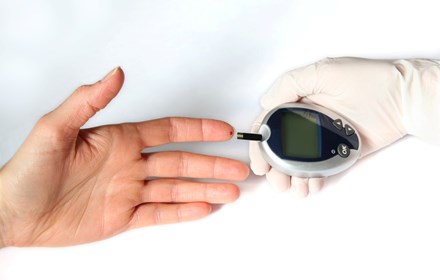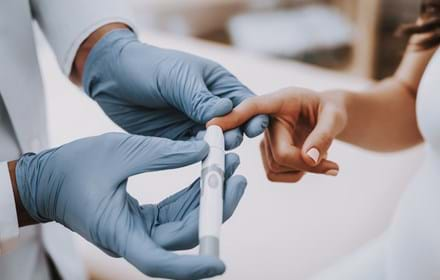
DRWF Research in focus: Measuring the effects of kisspeptin on insulin secretion and the growth of beta cells
We take a look at the work of Dr James Bowe who was awarded the DRWF Professor David Matthews Non-Clinical Fellowship in 2008.
Dr James Bowe is a reader in endocrinology and diabetes in the Department of Diabetes at King’s College London.
In his own words, Dr Bowe discusses his DRWF-funded research work.
Research origins
“At the time I received the Professor David Matthews Non-Clinical Fellowship in 2008, I was a postdoctoral researcher, having finished my PhD in 2006.
“After my PhD I moved into diabetes research before completing my first postdoctoral research.
“The DRWF Fellowship gave me several opportunities to move forward. Firstly, it enabled me to take ownership of a project allowing me to initiate and independently plan experiments. This was helpful in terms of laying the groundwork for subsequently building an academic career and to establish my own research lab. The award gave me a stepping stone which allowed me to take ownership of a project while at the same time having the support of a supervisor and colleagues around me.
“The DRWF Fellowship was a springboard for the development of my diabetes research career. It was a catalyst for securing a lectureship position at King’s. The research that I conducted throughout the Fellowship and the results from this work provided the basis for subsequent grant applications, enabling me to recruit my own PhD students, my own post-doctorate research projects, and start to build my own independent lab.
“The title of my 2008 DRWF Fellowship was ‘Measuring the effects of kisspeptin on insulin secretion, and on the growth and survival of beta cells’.”

Sweet connection
“Kisspeptin is an interesting signalling hormone. It got its unusual name as it was originally discovered in a town called Hershey, Pennsylvania, in the US. For anyone that doesn’t know, this is the American equivalent of Cadbury’s, where they make Hershey’s chocolates. One of their most famous exports is these little chocolate drops called Hershey’s Kisses. So, when researchers in this town discovered this new signal, they named it after the town’s most famous export and called it kisspeptin.
“It was found to have a really important role in puberty and in controlling adult reproductive function. Individuals with mutations or defects in kisspeptin or the kisspeptin receptor effectively don’t go through puberty and have no adult reproductive function. So, the vast majority of the work looking at kisspeptin over the past 20 years or so has really focused on this very important role in terms of regulating reproductive function.
“The reason that we became interested was because there are also very high levels of the kisspeptin receptor within the islets in the pancreas. When I started off down this path, there really wasn’t any research looking at why that might be, so it was a novel area of research. It wasn’t obvious at all why the islets might have these very high levels of the kisspeptin receptor.
“Kisspeptin is found in various areas of the body. It’s found in the brain, and most of the effects on reproductive function and puberty are due to effects within the brain. It is also found in various different tissues, as is the receptor. Like I say, the receptor and kisspeptin itself is found in the islets within the pancreas so that’s why we were interested.
However, there are also very high levels of kisspeptin made by the placenta during pregnancy and lower levels in various other tissues, such as the liver, the lymph nodes, the testes and ovaries.
“Most of the research has focused on the role of kisspeptin in reproductive function, leading to an increased understanding of the effects in terms of reproductive function. But with the expression of kisspeptin in various other different tissues there is also increasing interest in trying to work out its involvement in these other different systems.
“Obviously, I’m particularly interested in the islets and effects relating to diabetes, but there are other groups out there interested in the roles in other different tissues as well.”
Insulin release
“In my early postdoctoral research before I started the Fellowship, I was looking at what kisspeptin might do to the islets and I had shown that it seems to stimulate insulin release and has various different effects on the islet function in the pancreas.
“With the DRWF Fellowship, I aimed to build on that and to look at this area in far greater detail. The big question that I really wanted to answer was why kisspeptin has these effects on the islets. Kisspeptin seems to stimulate the islets, and particularly to stimulate insulin release, so what is the purpose of this effect in the body? What kind of biological states might kisspeptin play a role in, and why might a signal that is most associated with reproductive function have this additional role in terms of stimulating insulin release?
“We started to look at whether kisspeptin might play a role during pregnancy. Part of the reason for that was because, under most normal circumstances, the levels of kisspeptin circulating in the blood are extremely low, virtually undetectable. The one exception to that is where it is expressed in very high levels in the placenta during pregnancy.”
Kisspeptin impact on pregnancy
“It turns out that during pregnancy, levels of kisspeptin increase by thousands of fold in the maternal circulation due to release from the placenta. We thought that because pregnancy was one of the very few states where the islets would actually be exposed to very high levels of kisspeptin it might play a role there.
“During a normal healthy pregnancy you have a gradual progressive increase in insulin resistance across pregnancy. This leads to a mild pre-diabetes state during pregnancy and that’s completely healthy. The reason why that is useful is because it means that the mother takes longer to absorb glucose from the blood. This prioritises the glucose supply to the foetus, meaning that the growing foetus can take up more glucose from the blood.
“It is a beneficial mechanism. But you don’t want that insulin resistance to go too far and you don’t want it to develop into diabetes. Therefore, in parallel with that increase in insulin resistance, the islets in the pancreas also have to adapt to help compensate by producing more insulin and increasing rapidly in number.
“The islets grow in size and they release more insulin during pregnancy. The question that we were interested in at that point was what are the signals that tell the islets to adapt? How do the islets know that they’re in a pregnant woman and that they need to grow, that they need to be making more insulin, in order to compensate and to help cope with the demands of pregnancy? Is kisspeptin one of the signals that’s involved in communicating from the placenta to the islets? Communicating that the islets are in a pregnant woman and that they need to adapt by increasing their insulin secretion and growing to meet that increased demand?”
Non-clinical studies
“We looked at this through different non-clinical studies, and in fact it turned out to be the case that kisspeptin does play a role in the islet adaptation to pregnancy. You see a lot of the effects in response to treating islets with kisspeptin that you would normally expect to see during pregnancy. Similarly, if you look at it the other way around and administer a kisspeptin antagonist in non-clinical models, you block the effects of the kisspeptin present in the body and reduce the adaptation of the islets to pregnancy.
“If you block the effects of kisspeptin the islets don’t release as much insulin and they don’t grow to the same extent during pregnancy, and as a result the mother becomes glucose intolerant. This was the main finding that came out of the Fellowship, establishing the idea that kisspeptin might play an important role in terms of communicating from the placenta to the islets, signalling that the islets need to adapt in order to cope with the demands of pregnancy.
“If that signal from the placenta is missing, or if the signal is blocked in any way, then that can potentially cause issues in terms of the mother’s ability to cope with those metabolic demands.
“The hypothalamus, placenta and endocrine pancreas are involved in the long-term regulation of energy balance. The hypothalamus, sitting at the base of the brain, is where kisspeptin is involved in reproductive function. It also plays a role in glucose sensing and various other mechanisms that involve communication with the islets. The placenta also strongly influences islet function, but that communication is obviously most important during pregnancy itself.
“Therefore, once pregnancy comes to an end the placenta is gone and there is not a long-term communication between the placenta and the islets beyond this. But it’s worth noting that the impaired glucose homeostasis (inability to control blood sugar levels) during a gestational diabetes pregnancy does seem to have quite long-term effects. For example, it is known that women who develop gestational diabetes are much more at risk of developing type 2 diabetes later in life.”

Risk of developing type 2 diabetes after pregnancy
“This is something that I have recently become interested in, the longer-term consequences of impaired glucose tolerance during pregnancy on later life risk of developing type 2 diabetes. There’s a question there about whether the gestational diabetes is causative for later-life type 2 diabetes. Does the fact that an individual has developed gestational diabetes actually cause the later-life development of type 2 diabetes? Or is it just that an individual’s pancreas and islets have a greater susceptibility to developing both gestational diabetes and type 2 diabetes? Maybe they would have developed type 2 diabetes even if they’d never been pregnant? These are the kind of questions that we’ve become interested in looking at more recently.
“Our initial work funded by the Fellowship measured the effects of kisspeptin on insulin secretion and on the growth and survival of beta cells during pregnancy. The information gained from the studies helped to identify possible new ways of modifying islet function with potential for future therapeutic applications. To further these findings, in 2013 we applied for and received a Pump Priming award from DRWF for a project entitled ‘Plasma kisspeptin in pregnancy and gestational diabetes’.
This was a small translational pilot study in pregnant women in collaboration with colleagues at King’s College Hospital. As a basic scientist, most of my research is done in non-clinical rodent models, but obviously pregnancy in study models is not the same as human pregnancy.
“We wanted to see if the mechanism that we had identified in our non-clinical mouse model during my Fellowship was relevant in human pregnancy. We took blood samples from pregnant women who were undergoing routine glucose tolerance tests as part of pregnancy in order to try to diagnose gestational diabetes.
“We were interested in looking at whether there was any difference in kisspeptin levels between women who developed gestational diabetes and those who did not. What we found was that, firstly, women who were diagnosed with gestational diabetes had significantly lower circulating levels of kisspeptin than women with healthy pregnancies.
“Secondly, we found that women with lower circulating kisspeptin levels during pregnancy released less insulin in response to a glucose challenge. As part of the glucose tolerance test, these women were given oral glucose, which causes an increase in the circulating insulin levels.
“In women with low circulating kisspeptin levels there was less of an increase in insulin release in response to glucose, and women with high kisspeptin levels had more of an increase in insulin release.
“The indication is that kisspeptin also plays a role in human pregnancy and that low circulating kisspeptin may be one of the reasons why some women develop gestational diabetes.”
“I certainly would not suggest that low circulation of kisspeptin is the only reason why women develop gestational diabetes. There are lots of different factors. But it may contribute to the development of gestational diabetes. Although I’m not a clinician myself, I am aware of clinical colleagues who have taken this knowledge forward and it may have clinical or therapeutic applications in the future.”
Identifying risk of developing gestational diabetes earlier
“One of the issues with gestational diabetes is that it can only be diagnosed once it’s developed. It is generally diagnosed by glucose tolerance test once the mother has developed this form of diabetes. There is a lot of interest clinically in screening studies that could be done earlier in pregnancy to identify women that are particularly at risk of developing gestational diabetes so we could intervene sooner because, in theory, the earlier we can intervene the better the outcomes.
“I have clinical colleagues who are currently looking into developing screening strategies, testing different markers that you could measure during early pregnancy to try to identify women at risk of gestational diabetes. It is unlikely that there will just be a single marker that we can measure that will identify women at high risk, but kisspeptin is one of the markers they’re interested in looking at as part of a larger screen.”
Using kisspeptin in treating type 2 diabetes
“I am also aware that there are currently clinical trials ongoing to test whether kisspeptin might be therapeutically useful in diabetes generally, particularly type 2 diabetes.
“We think that kisspeptin in the body is most involved during pregnancy in the islet adaptation to pregnancy, the way that it works by stimulating insulin release from the islets and by stimulating the growth of the islets.
“Although our focus in terms of the role of kisspeptin in the body has mainly focused on pregnancy, there’s a lot of potential there that it might be therapeutically useful in type 2 diabetes.
“It is really pleasing to see this non-clinical science translating into human study. We do a lot of work in the lab trying to understand mechanisms and looking in other models or cell lines or tissue samples. Sometimes, it can be difficult to see how this very detailed, mechanistic research is going to extrapolate in years to come into clinical or therapeutic treatment.
“Seeing clinical colleagues taking that forward and exploring screening for early identification and diagnosis of gestational diabetes, as well as looking at potential therapeutic uses, is hugely rewarding.”
Working with DRWF
“I am grateful for the opportunity that the DRWF Non-Clinical Fellowship gave me back in 2008. Basic science, and the funding for such, is incredibly important. The work is detailed and mechanistic and it can take a few years to bring results to fruition, it’s a gradual process. However, it’s the first step in enabling research that really does translate into future clinical and real-world benefits that hopefully will improve diabetes care for all.”
This article was originally published in the October 2022 edition of Diabetes Wellness News. For more information and to subscribe to the DRWF quarterly newsletter visit here

Join DRWF's Claire Levy as she discusses diabetes with healthcare professionals and people living with diabetes. Our Living with Diabetes podcast aims to share accurate information and tell inspirational stories about diabetes. Meanwhile, our DRWF Podcast Pro series is an occasional podcast series aimed at professionals, where we discuss diabetes care with leading healthcare professionals.
Listen to our podcasts here
I would like to make a regular donation of
I would like to make a single donation of
There are lots of ways to raise money to support
people living with all forms of diabetes.
Bake, Swim, Cycle, Fly ... Do It For DRWF!
Fundraise with us
Recent News


